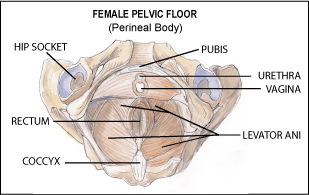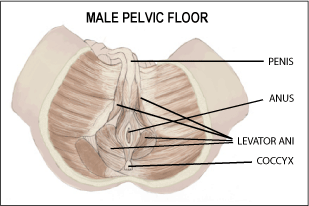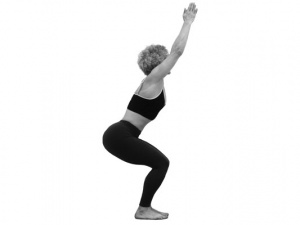Pelvic Floor Training
Incontinence



Powerful Pose
Stand feet close together (touching if possible), weight on heels, toes pressed down, arches and ankles lift up, sitting bones press down. Do not arch the low back. Upper thighs press down, sternum lifts up, draw abdominals into spine, arms lift from shoulders and straighten. Palms face in, shoulders release down the back, neck lengthens, gaze either forward or, if natural, look up to hands. MODIFICATION: Hands rest on upper thighs. Other choice: softer bend in knees/or sit on edge of chair. [/two_third_last] [clear]
PELVIC FLOOR TRAINING (Incontinence)
Pelvic muscle exercises (PME’s) when practiced regularly and correctly will increase strength in the Levator Ani muscle. These exercises will also help firm, thicken, broaden and bulk the deeper muscle fibers to increase muscle endurance and support the urethral sphincter and detrusor (bladder) muscles. This will prevent stress urge and urinary incontinence.
The Levator Ani muscle is like a sling and consists of a striated skeletal muscle group that is totally voluntarily controlled. Most of the Levator Ani muscle fibers are composed of Type I or Slow Twitch muscles. Slow Twitch muscles are long endurance and slow to fatigue. This part of the muscle fiber must be worked by holding less strong contractions for longer holding periods. About a quarter of the Levator Ani is Fast Twitch muscle (or fast fatigue) Type II. Type II muscle is worked with quick contractions, two-seconds and release.
The floor of the pelvis is made of muscle and fascia. The perineal body is important because it is the point of insertion for eight muscles. The deep transverse perineal muscle runs from the perineal body and connects to the ischeal tuberosity (top of the hip socket). The superficial muslces of the perineal membrane are the external sphincter and the external anus and connects to the coccyx and anterior Levator Ani.
Practicing PME’s in Primiparas (women who have given birth) results in fewer incontinence episodes during the last trimester of pregnancy and postpartum. For chair-bound seniors, the practice of pelvic muscle rehabilitation, PME’s, and bladder retraining programs have successfully decreased urinary incontinence.
RULES OF ENGAGEMENT :
- Locate correct muscles. Improve your awareness of your urinary sphincter. Look at the diagram and picture the sling of muscles next to your coccyx (tail bone) and on both sides of your rectum and urethra. Try squeezing up and into the center of your body as if you could lift your spine from the bottom of the tail bone and raise it several inches.
- Quick Lifts. Squeeze Levator Ani and hold two seconds as if you were trying to stop the flow of urine and then release. Do these quick lifts until the onset of fatigue in the pelvic floor.
- Long Holds. Use Utkatasana (Chair Pose/Powerful Pose). Bring your thighs together as if you were zipping a zipper from your knees to your inner thighs. Squat down, bending your knees until you feel a contraction in your pelvic floor and abdominals. Squeeze your Levator Ani and hold the squeeze for three long Ujjayi breaths. Continue to squeeze and release for three breaths until fatigue sets in.
- DO NOT SQUEEZE YOUR BUTTOCKS. Let your gluteal muscles contract, but not “clench”. Feel the tension while performing quick lifts and long holds coming directly from the pelvic floor by lifting up the rectal sphincter. Do NOT bear down.
- Three Positions. Start by doing #2 and #3 lying down, then sitting, and finish with standing.
[clear]